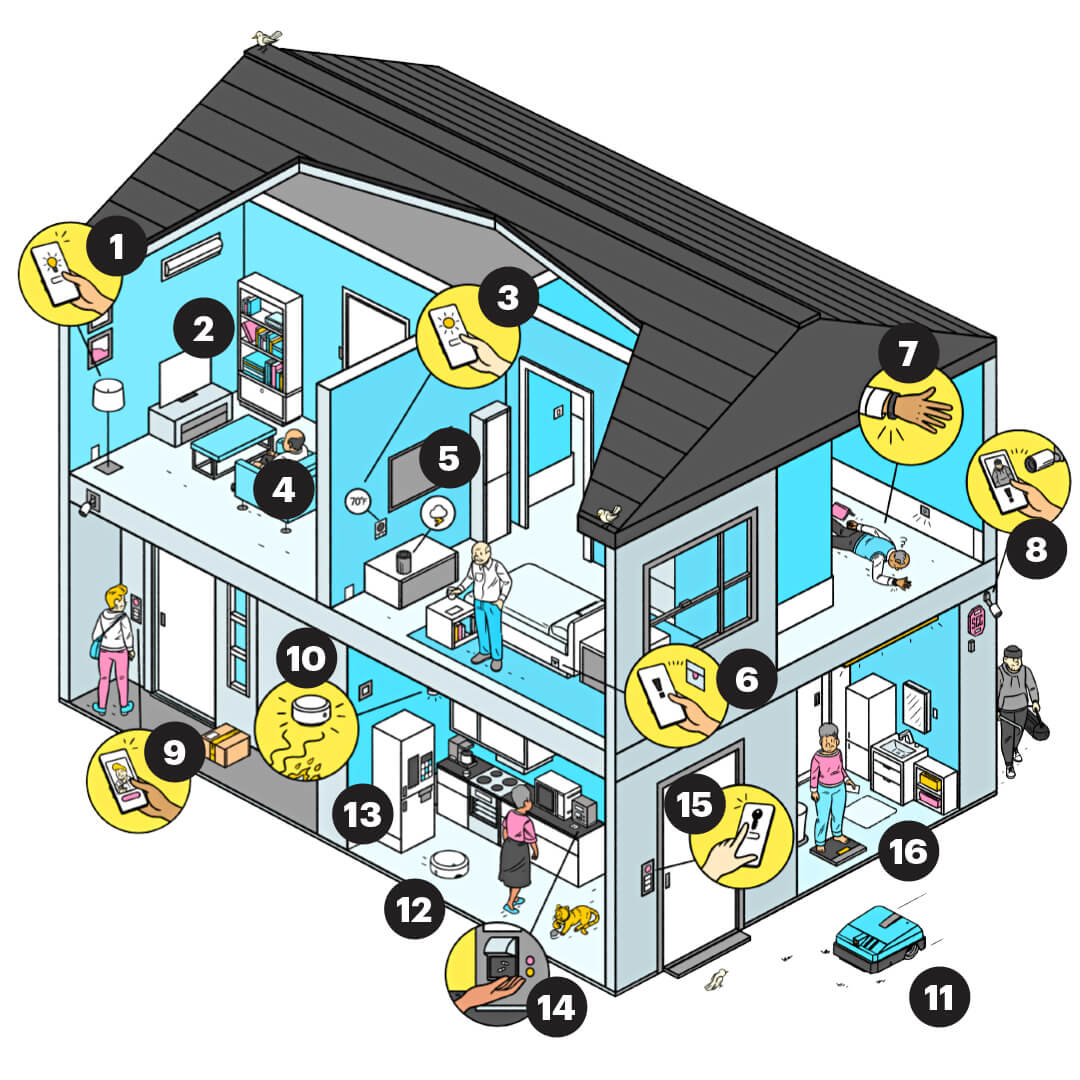Your Life
A SMART HOME GUIDE
How technology can make daily life easier for older people—or caregivers

Getting older doesn’t have to mean leaving your home. New technology promises to make aging in place easier, safer and more satisfying. In some cases, it can even lend a hand to caregivers.
Smart tech that is connected to the internet can often be controlled from anywhere inside or outside the home. Some of the most useful devices learn your preferences and routines and adjust to you. Or they provide insight to a loved one who helps out.
“What becomes even more valuable with smart devices is when data reveals behavioral patterns that could alert a caregiver when something seems off,” says Andy Miller, senior vice president of AARP Innovation Labs.
Here’s a look at products that can help around the house.
1. SMART LIGHTS
Can be turned on and off through an app. Can be programmed to turn on when detecting movement for security outside your home or safety inside it, such as when a person gets up at night.
2. SMART TVS
Sure, you spend countless hours streaming movies, shows, live news and sports with an internet-connected TV. But smart TVs can also use a webcam for video chats, telehealth calls with your doctor or virtual exercise sessions.
3. SMART THERMOSTATS
Typically can learn your indoor climate preferences over time. When the thermostat detects the house is empty, it can reduce the amount of heating or cooling, shaving a few bucks off your energy bill. Includes remote control through an app, for the resident or a caregiver.
4. SMART SPEAKERS
With voice commands, you can play music, get the weather forecast, get questions answered and more. This can become the command center for your home, providing voice control for other products. Smart speakers are also popular in the kitchen for setting timers.
5. SMART BEDS/MATTRESSES
Can determine comfortable temperatures for whoever is sleeping in the bed. Can adjust mattress firmness and report on the quality of sleep come morning, perhaps sharing data with a health care provider or caregiver.
6. ACTIVITY SENSORS
Caregivers can monitor an older adult’s daily activities, such as getting out of bed, entering or exiting a room, or leaving an exterior door open. They can track daily activities to send alerts to family or a caregiver if, for example, a chair is occupied for too many hours.
7. FALL DETECTORS
Many of these products work with a combination of wall-mounted sensors and wearable devices, such as a wristband or pendant. They can determine if a resident has taken a fall and can call for help. A caregiver can also receive an alert.
8. SECURITY SYSTEMS
If an alarm is triggered, not only are the resident and authorities alerted, but the system can send a notification to a caregiver’s smartphone.
9. VIDEO DOORBELLS
These include a small camera, plus a microphone and speaker, which let you see and converse with someone at your door through an app on your phone. That person doesn’t see you and won’t know if you’re home. Some models can regularly record video for review.
10. SMOKE DETECTORS/CARBON MONOXIDE DETECTORS
Smart alarms can not only alert people in the home about smoke but also push notifications to an app for a caregiver. Apps can receive notifications if carbon monoxide or other indoor air quality issues are detected.
11. ROBOT MOWERS
These follow an area that you define and quietly do the mowing for you.
12. CLEANING ROBOTS
These started as automated sweepers that learned the layout of your rooms and did the dirty work; now some can also mop hard floors.
13. SMART APPLIANCES
A smart refrigerator allows contents to be seen in an app, if you can’t remember what you have or need while shopping. In some cases, it can suggest recipes based on the ingredients on hand. A smart stove will let you or a caregiver shut off an oven remotely. A smart microwave can be turned on or off remotely via an app.
14. MEDICATION DISPENSERS
Can be programmed to give out the right amount of medicine and audibly or visually alert a person when it’s time to take a dose. Many can be managed through phone apps, so a caregiver can check to see when medication has been dispensed.
15. SMART LOCKS
Lock and unlock doors remotely and monitor comings and goings—perhaps of a loved one with dementia who may wander. Convenient for remotely providing access to health aides, house cleaners and other family members.
16. BATHROOM TECH
Smart water sensors can shut off water and alert you if a leak or a constantly running toilet is detected. Smart scales are useful to track weight and other body measurements and send the data to a health app or share it with caregivers or medical providers. Sensors can indicate how often someone opens a medicine cabinet.
For more guidance on smart homes, visit AARP’s Personal Technology Resource Center’s caregiving section at aarp.org/caretech.